An update on GenAI
In Spring 2024, DIT administered a campus-wide survey on GenAI in teaching and learning, in partnership with the Division of Student Affairs. The 2024 EDUCAUSE survey asked questions along many similar topics concerning GenAI. Although it was administered only one semester later, a semester is a long time in the lifespan of this new, ever-evolving technology, and the findings therefore offer an opportunity to examine how student and instructor perceptions may be stabilizing or changing.
Students and instructors share similar perceptions regarding acceptable student uses of GenAI
In our campus-wide survey, we identified several areas in which student and instructor perceptions converged, most notably their shared concerns around academic integrity. The current survey extends this finding to their perceptions regarding acceptable academic uses of GenAI. Figure 6 shows the percentage of students who said they use GenAI for each listed academic practice (in gray), as well as the percentage of instructors who said that using GenAI for that purpose should be allowed (in red). There is no single practice for which a majority of students said they use GenAI. However, the practices for which a substantial percentage of students did say they incorporate it—including brainstorming and idea generation (49%), outlining and organizing (38%), and refining ideas or questions (35%)—are also the ones that instructors were more likely to indicate as allowed.
Notably, these top practices are somewhat consistent with the top practices that students listed in the campus-wide survey, which were generating ideas, improving content, and summarizing concepts. However, overall use may be higher in Fall 2024, with 68% of respondents indicating that they used GenAI in at least some way in their courses, whereas only 41% of respondents in the Spring 2024 survey said they use GenAI for academic coursework. While the exact numbers are difficult to compare due to differences in the wording of questions and item stems, the available evidence does suggest that GenAI adoption among students for academic work may be increasing, but they continue to use it in ways that enhance rather than replace their work.
Overall, student uses of GenAI (gray) align with instructors’ allowed uses (red) in the classroom.
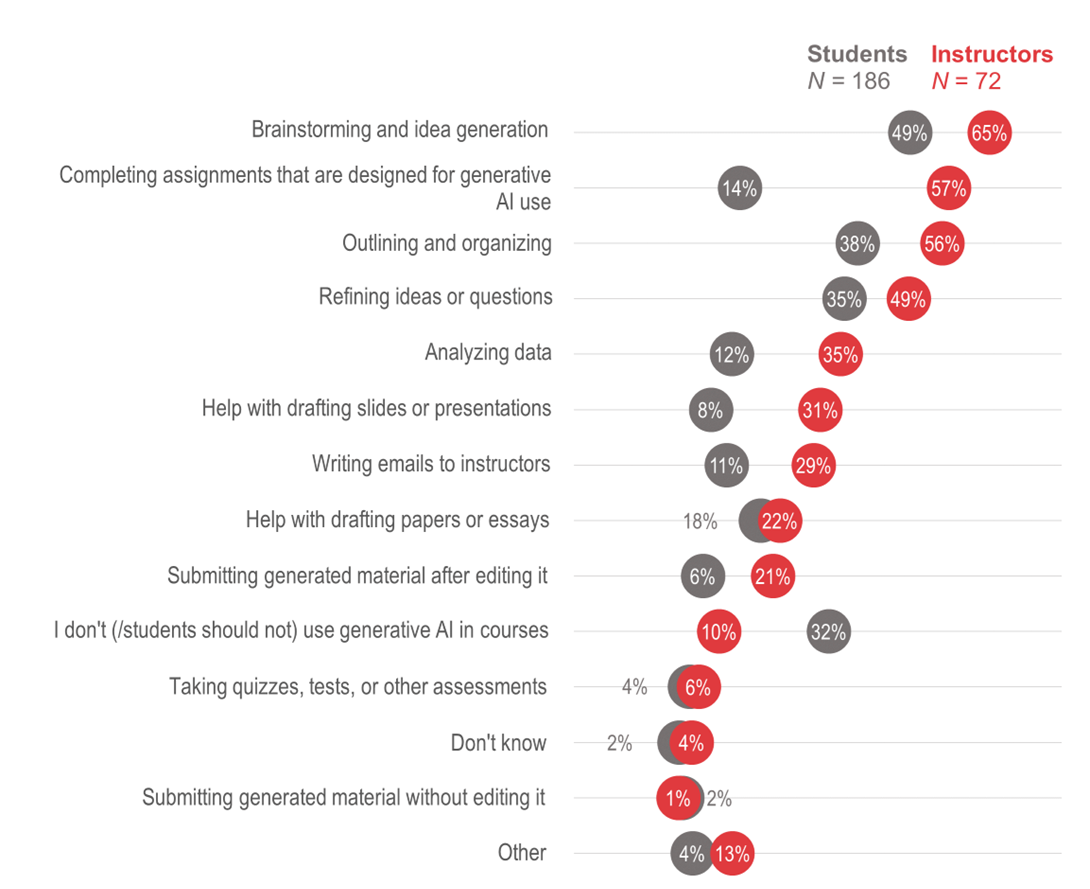
Figure 6. In gray, student responses to the question: “For which of the following purposes, if any, are you currently using generative AI in your courses? (Select all that apply).” In red, instructor responses to the question: “For what purposes, if any, should students be allowed to use generative AI in their courses? (Select all that apply).”
In a write-in response question, instructors were asked to explain the reasons for their selections in the above figure. Most indicated that they saw AI as a secondary tool (27 comments, 73%), which if leveraged appropriately should enhance learning, not substitute for it. Several pointed out the need to teach students appropriate use (10 comments, 27%). One instructor said, “I think of AI as a tool, like a calculator. It can do some of the work for you, but you can't use it mindlessly. As educators, we need to teach students to use it critically.”
The relative concordance between student uses of GenAI, and instructors’ perceptions of allowed student uses, may help explain why a plurality of students (39%) feel that most instructors are fully aware of the ways they use GenAI (Figure 7). Many students may correctly assess that the ways in which they incorporate GenAI into their coursework are allowed, possibly because instructors have discussed it with them (see section on classroom approaches to GenAI below). However, almost as many students (35%) believe that instructors are either not aware of some of the ways that they use GenAI, or not at all aware of their uses.
Most students who use GenAI maintain that instructors are aware of at least some of their uses of it.
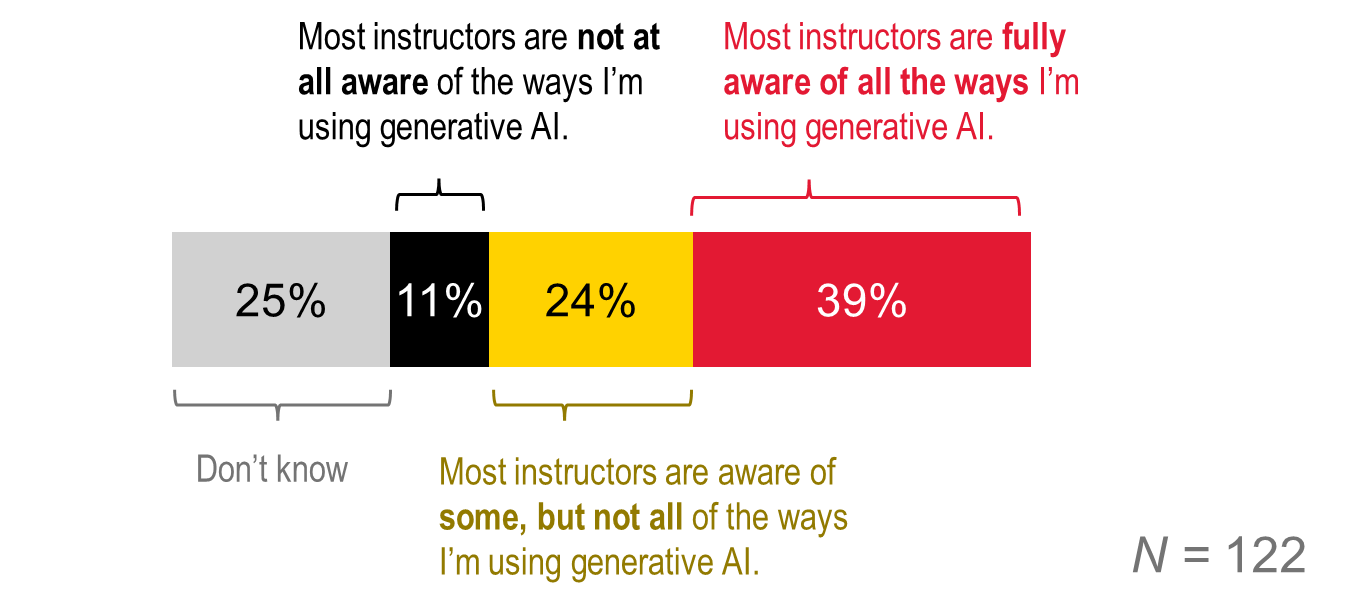
Figure 7. Student responses to the question, “Thinking about the purpose(s) you selected above, what level of awareness do most of your instructors have of the ways you’re using generative AI in your courses?”
Most instructors still do not use GenAI in their courses, but there are signs of increasing use of the technology.
One finding of the campus-wide survey was that a greater percentage of students had adopted GenAI into their academic work compared to instructors, only 23% of whom said they used GenAI for instructional work. In the current survey, 39% of instructors selected at least one practice for which they have used GenAI in their courses (Figure 8)—still a minority, but a higher percentage compared to Spring 2024. (Although note that, in the current survey, only 22% said they incorporate GenAI into their teaching specifically, which may be closer to how they interpreted the question in the campus-wide survey.) Like students, the most frequent use of GenAI among instructors was for brainstorming and idea generation.
Most instructors still do not use GenAI in their courses.
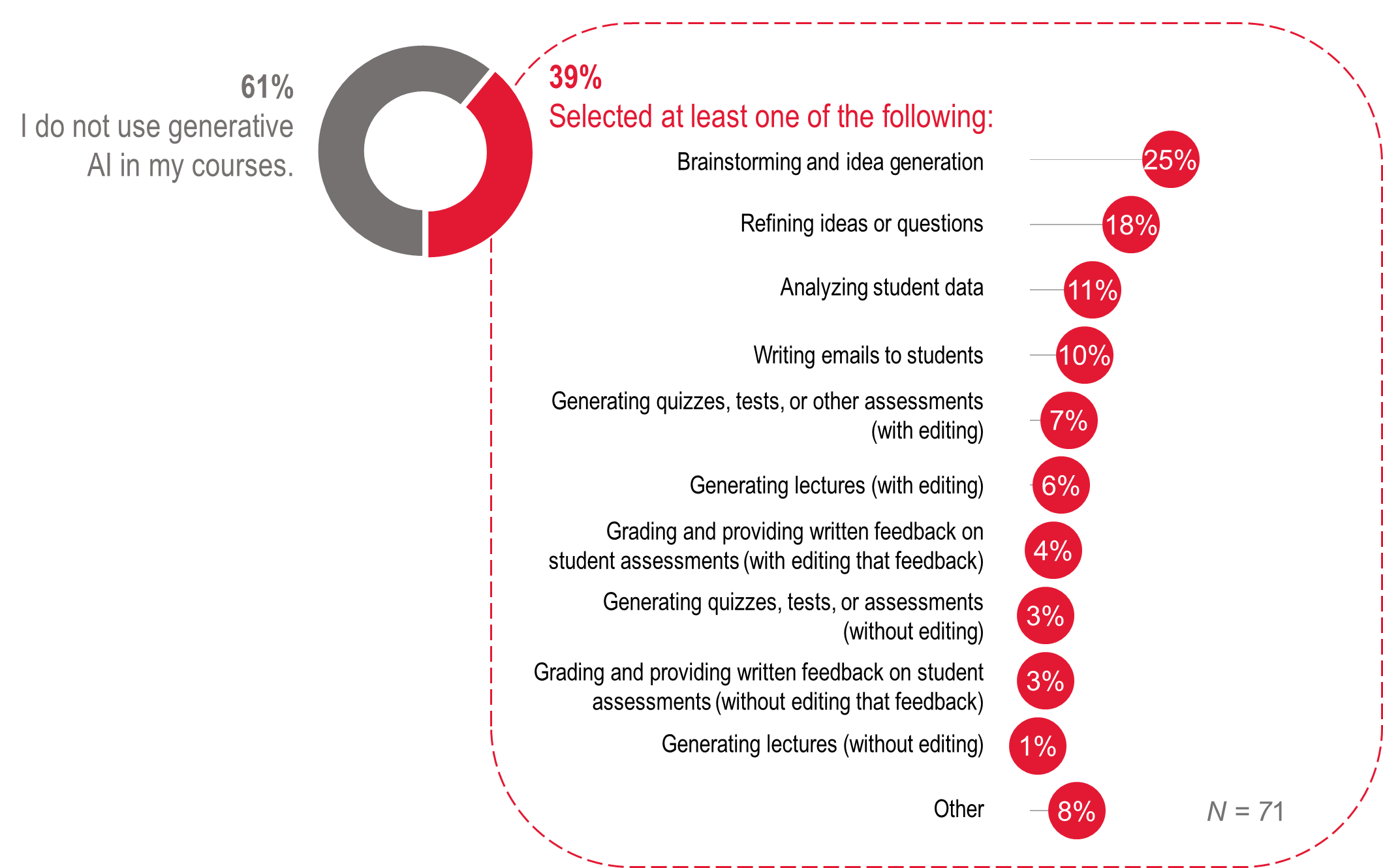
Figure 8. Instructor responses to the question: “For which of the following purposes, if any, are you currently using generative AI in your courses? (Select all that apply.)”
There are some indications that usage of GenAI will continue to increase among instructors in subsequent semesters. First, when asked about their general dispositions towards GenAI, more instructors said they were optimistic or very optimistic (37%) compared to pessimistic or very pessimistic (24%) (Figure 9), a surprising finding given their concerns about student use. Additionally, a slight majority of instructors said that they either already incorporate GenAI into their teaching (22%) or that they plan to (35%).
Instructors diverge in their dispositions toward GenAI, but optimism outweighs pessimism.

Figure 9. Instructor responses to the question: “Please rate your general disposition towards generative AI.” Instructors who selected “Don’t know” (n = 2) are omitted.
Discussion about GenAI is more common than active integration of the technology into pedagogical practices.
There are many layers according to which instructors might approach GenAI in the classroom, from prohibiting it entirely, to discussing appropriate uses, to actively incorporating it in coursework. In our campus-wide survey, 62% of students said that at least some of their instructors had specified which uses of GenAI are allowed, and which are not allowed. In the current survey, 91% of students said that instructors had provided clear guidance about the do’s or don’ts of GenAI, possibly representing an increase in instructors engaging in these conversations with students. Only about a fifth of students (21%), however, said instructors have actively found ways to incorporate GenAI (Figure 10).
Most students have received some guidance from instructors, but far fewer have experienced active integration of GenAI by instructors.
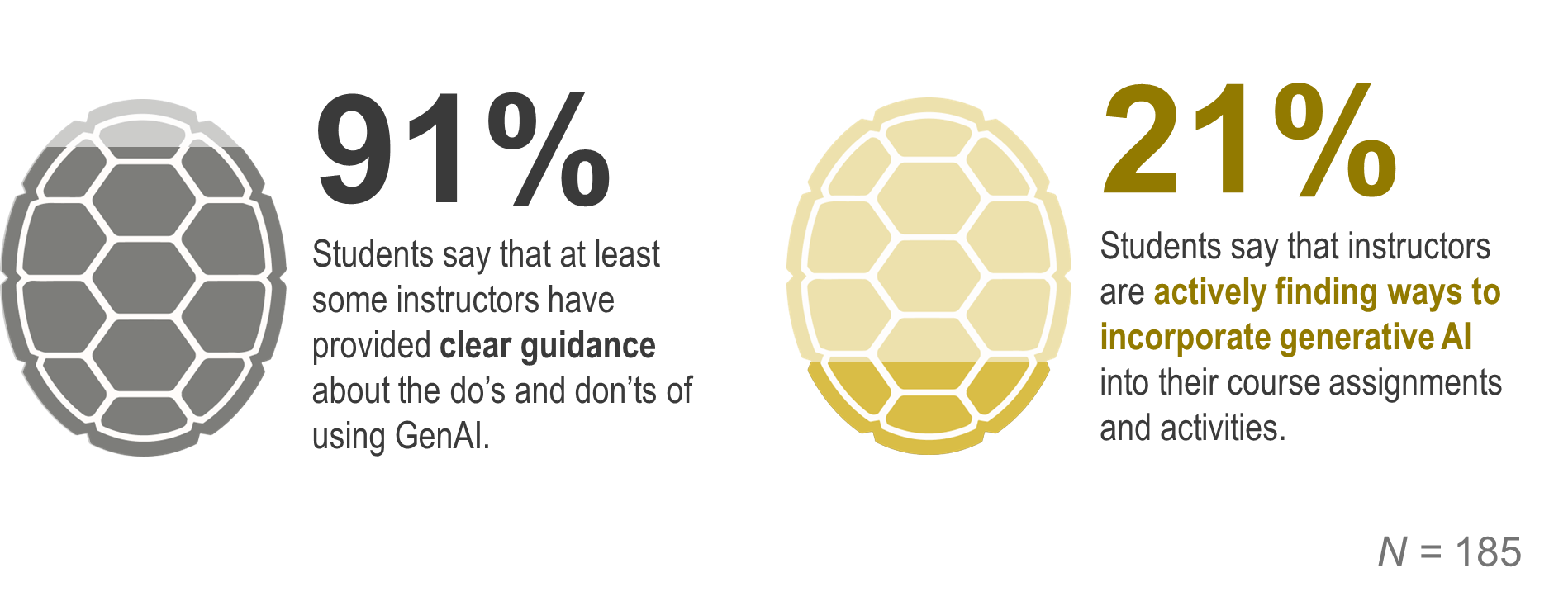
Figure 10. Left: Student responses to the question: “Overall, how many of your instructors have provided clear guidance about the do’s and don’ts of generative AI.” (% selected Some, Most, or All). Right – Student responses to the question: “Overall, are your instructors actively finding ways to incorporate generative AI into your course assignments and activities?” (% selected Yes).
When asked about the extent to which their instructors were prohibiting or encouraging student use of GenAI, students reported experiencing a variety of classroom policies, with a plurality (48%) saying that some instructors had prohibited it, while others allowed it (Figure 11). However, a much greater percentage of students reported that most or all of their instructors were prohibiting it (38%) compared to students who said that most or all of their instructors were allowing it (8%).
Students are experiencing a variety of policies regarding GenAI, with restrictive measures being more common than permissive measures.
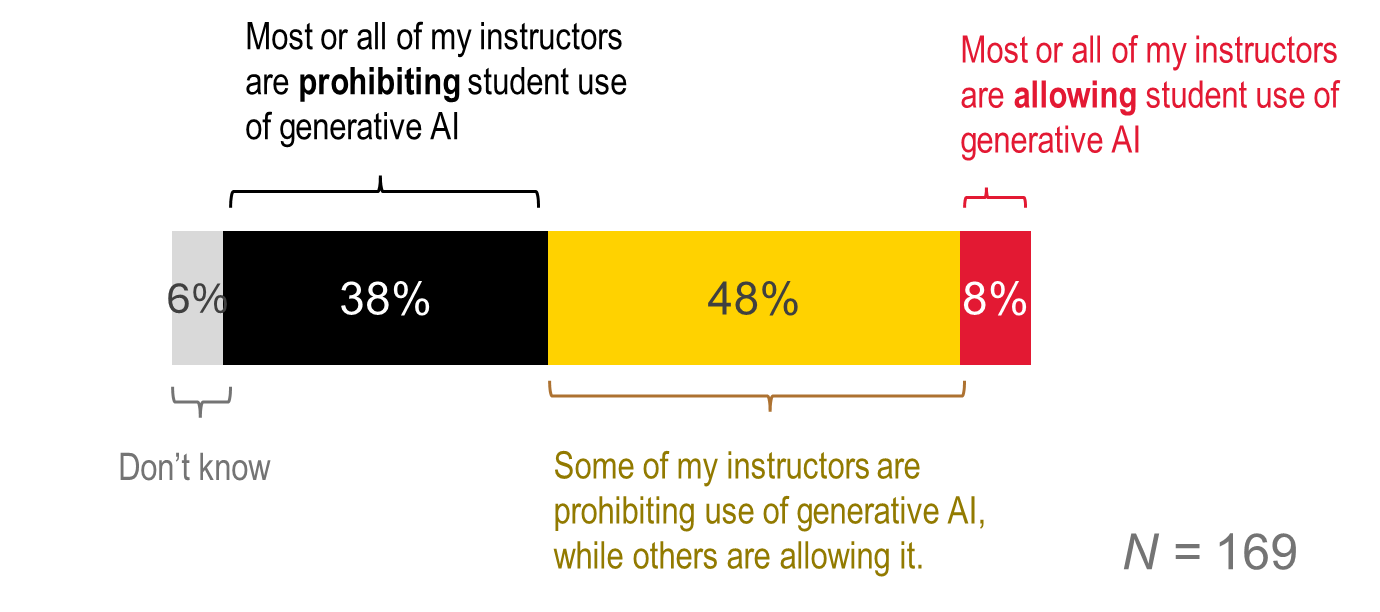
Figure 11. Student responses to the question: “To what extent are your instructors prohibiting or encouraging student use of generative AI in their courses?”
Taken together, the data suggest that most instructors recognize the use of GenAI as a topic that they need to address from the standpoint of classroom policy which may help address students’ concerns about how to use GenAI without violating instructors’ policies. However, fewer instructors are teaching students how to use it through integrated coursework. Notably, 3 in 4 students (73%) expect to use GenAI in their careers, and of those students, most (58%) say that UMD is not giving them the experience and training with GenAI that they need (Figure 12). Of course, as discussed in the section on workforce preparedness, technology-specific training does not necessarily fall within the purview of UMD’s undergraduate program, let alone of any one instructor. However, this finding does suggest an opportunity for interested instructors to consider how they might incorporate GenAI training within their discipline.
Students expect to use GenAI in their careers, but do not feel that UMD is providing them the training they need.
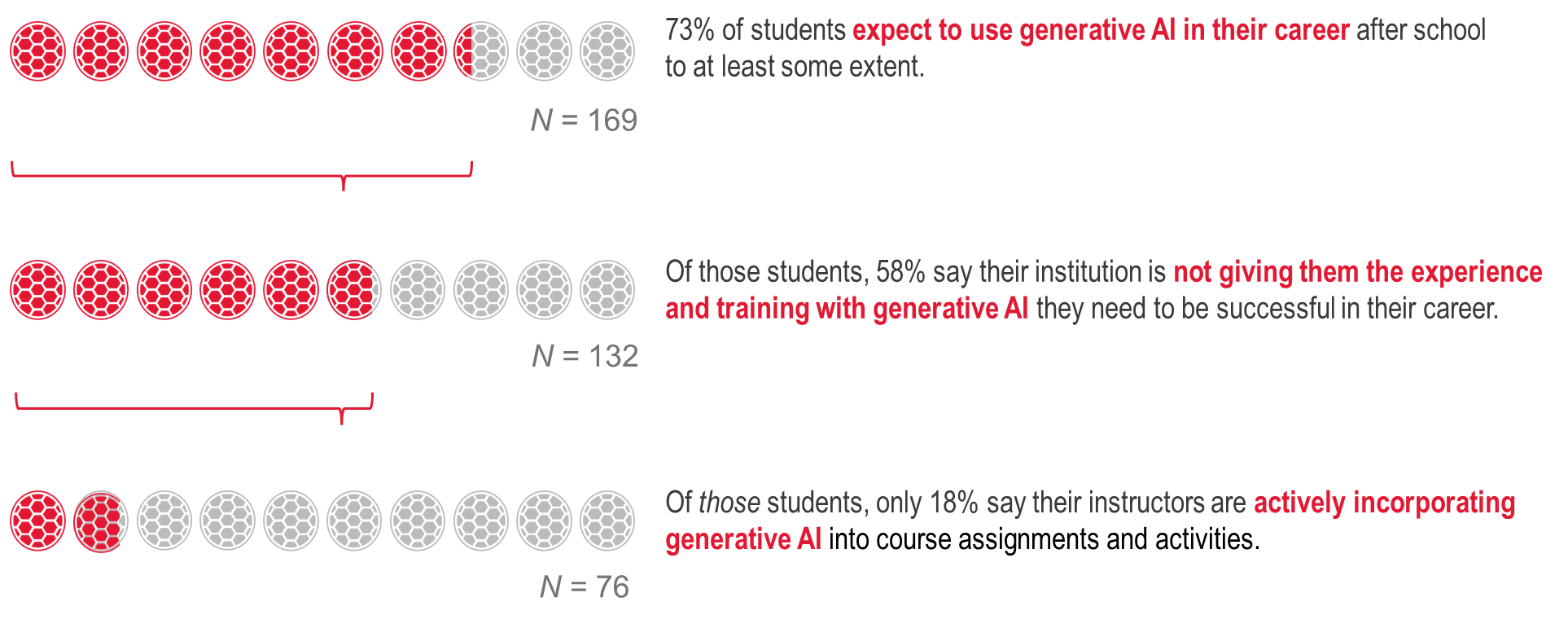
Figure 12. Student responses to the questions, from top to bottom: “To what extent do you expect you will have to use generative AI in your career after you’re finished with school?” (% selected “To some extent” or “To a great extent”); “Is your institution giving you the experience and training with generative AI that you are going to need to be successful in your career?” (% selected “No”); “Overall, are your institutions actively finding ways to incorporate generative AI into your course assignments and activities?”
Students who said that they expected to use GenAI in their careers were asked to write in the ways in which they expected to use it. A thematic analysis of their responses showed that the most common responses involved discipline-specific use cases (40 comments, 36%), such as programming, learning policy, or predicting outcomes of species populations. More generally, however, students expected to use GenAI in their careers for brainstorming (30 comments, 27%), data analysis or research (29 comments, 26%), generating content (16 comments, 14%), summarizing (14 comments, 13%), and editing (12 comments, 11%). Many students seemed to recognize the concerns around GenAI but nonetheless expect to employ it where appropriate and useful. For example, one student said, “As a future journalist, it won't be considered ethical to use generative AI to write. However, it will be helpful in other areas like generating questions for interviews and/or summarizing long transcripts of an interview.” Another student said that they will use it “to do what I’m doing now. I never use it to cheat but it’s helpful when I’m doing things like organizing my thoughts or getting AI to explain something more in depth for me.”
